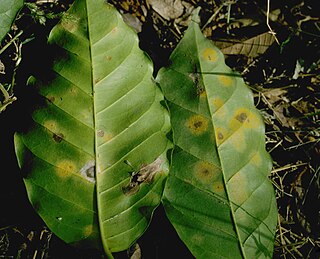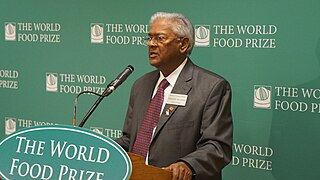
Rusts are fungal plant pathogens of the order Pucciniales causing plant fungal diseases.

Triticale is a hybrid of wheat (Triticum) and rye (Secale) first bred in laboratories during the late 19th century in Scotland and Germany. Commercially available triticale is almost always a second-generation hybrid, i.e., a cross between two kinds of primary (first-cross) triticales. As a rule, triticale combines the yield potential and grain quality of wheat with the disease and environmental tolerance of rye. Only recently has it been developed into a commercially viable crop. Depending on the cultivar, triticale can more or less resemble either of its parents. It is grown mostly for forage or fodder, although some triticale-based foods can be purchased at health food stores and can be found in some breakfast cereals.

The International Maize and Wheat Improvement Center is a non-profit research-for-development organization that develops improved varieties of wheat and maize with the aim of contributing to food security, and innovates agricultural practices to help boost production, prevent crop disease and improve smallholder farmers' livelihoods. CIMMYT is one of the 15 CGIAR centers. CIMMYT is known for hosting the world's largest maize and wheat genebank at its headquarters in Mexico.

Hemileia vastatrix is a multicellular basidiomycete fungus of the order Pucciniales that causes coffee leaf rust (CLR), a disease affecting the coffee plant. Coffee serves as the obligate host of coffee rust, that is, the rust must have access to and come into physical contact with coffee in order to survive.

Stem rust, also known as cereal rust, black rust, red rust or red dust, is caused by the fungus Puccinia graminis, which causes significant disease in cereal crops. Crop species that are affected by the disease include bread wheat, durum wheat, barley and triticale. These diseases have affected cereal farming throughout history. The annual recurrence of stem rust of wheat in North Indian plains was discovered by K.C. Mehta. Since the 1950s, wheat strains bred to be resistant to stem rust have become available. Fungicides effective against stem rust are available as well.

Wheat leaf rust is a fungal disease that affects wheat, barley, rye stems, leaves and grains. In temperate zones it is destructive on winter wheat because the pathogen overwinters. Infections can lead up to 20% yield loss. The pathogen is a Puccinia rust fungus. It is the most prevalent of all the wheat rust diseases, occurring in most wheat-growing regions. It causes serious epidemics in North America, Mexico and South America and is a devastating seasonal disease in India. P. triticina is heteroecious, requiring two distinct hosts.

Elvin Charles Stakman was an American plant pathologist who was a pioneer of methods of identifying and combatting disease in wheat. He became an internationally renowned phytopathologist for his studies of the genetics and epidemiology of stem rust. Stakman is credited with improving crop yields both in North America and worldwide as part of the Green Revolution.
Spot blotch is a leaf disease of wheat caused by Cochliobolus sativus. Cochliobolus sativus also infects other plant parts and in conjunction with other pathogens causes common root rot and black point.

Ug99 is a lineage of wheat stem rust, which is present in wheat fields in several countries in Africa and the Middle East and is predicted to spread rapidly through these regions and possibly further afield, potentially causing a wheat production disaster that would affect food security worldwide. In 2005 the noted green revolution pioneer Norman Borlaug brought great attention to the problem, and most subsequent efforts can be traced to his advocacy. It can cause up to 100% crop losses and is virulent against many resistance genes which have previously protected wheat against stem rust.

Phakopsora pachyrhizi is a plant pathogen. It causes Asian soybean rust.

Plant disease resistance protects plants from pathogens in two ways: by pre-formed structures and chemicals, and by infection-induced responses of the immune system. Relative to a susceptible plant, disease resistance is the reduction of pathogen growth on or in the plant, while the term disease tolerance describes plants that exhibit little disease damage despite substantial pathogen levels. Disease outcome is determined by the three-way interaction of the pathogen, the plant and the environmental conditions.
The Borlaug Global Rust Initiative was founded in response to recommendations of a committee of international experts who met to consider a response to the threat the global food supply posed by the Ug99 strain of wheat rust. The BGRI was renamed the Borlaug Global Rust initiative in honor of Green Revolution pioneer and Nobel Peace Prize Laureate Dr. Norman Borlaug who worked to establish and lead the Global Rust Initiative.

Zoe Țapu was a Romanian agronomist who created an original variety of durum wheat, adapted to the climate in Central and Eastern Europe and other similar regions of the world. She was described as a pioneer of durum wheat breeding in Romania.

Dr. Sanjaya Rajaram was an Indian-born Mexican scientist and winner of the 2014 World Food Prize. He was awarded this prize for his scientific research in developing 480 wheat varieties that have been released in 51 countries. This innovation has led to an increase in world wheat production – by more than 200 million tons – building upon the successes of the Green Revolution. The Government of India awarded him India's fourth- and third-highest civilian awards Padma Shri (2001) and Padma Bhushan (2022).
Jane Glazebrook is an American botanist known for her work on understanding plant defenses against pathogens and increasing crop yields. She received her Ph.D. from the Massachusetts Institute of Technology in 1991 and is now a professor of Plant Biology at the University of Minnesota. She was the editor-in-chief of the journal Molecular Plant-Microbe Interactions. She is married to Fumiaki Katagiri, who also works at the University of Minnesota as a professor of Plant Biology.
Gene stacking is the combination of more than one gene for plant disease resistance, or crop productivity, or other horticultural traits. In plant breeding traditionally that means breeding those genes in, but increasingly also can mean genetic engineering. This can be achieved a few different ways, and gene pyramiding is one of those methods. Stacking of transgenes is yet more difficult than stacking natural genes, but especially in the case of pest resistance genes which require a significant financial investment to insert, is advantageous over other methods. Pathosystems with rapid evolution in the pathogen have long been considered good targets of stacking, to broaden and prolong resistance.
Sarrah Ben M'barek-Ben Romdhane is a Tunisian-Dutch crop researcher. She works on developing fungus-resistant wheat strains to reduce the toll of Mycosphaerella graminicola on yields.
Diane G. O. Saunders is a British biologist and group leader at the John Innes Centre and an Honorary Professor in the School of Biological Sciences at the University of East Anglia. Her research investigates plant pathogens that pose a threat to agriculture. She was awarded the Rosalind Franklin Award by the Royal Society in 2022.
Ralph Merrill Caldwell was an American plant breeder, mycologist, and plant pathologist. Through his work with the U.S. Department of Agriculture and Purdue University, he developed disease-resistant cultivars for a wide variety of plants, including widely-grown wheat cultivars.
Beat Keller is a Swiss molecular biologist and professor of plant molecular biology at the University of Zurich. He is known for his research on disease resistance in cereals.










